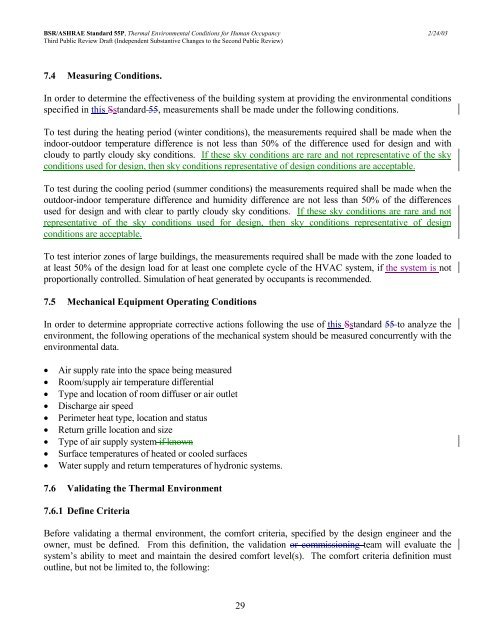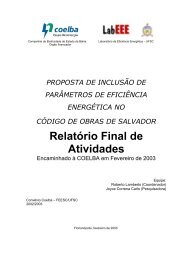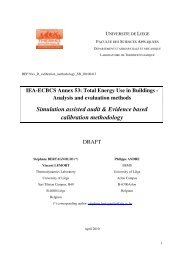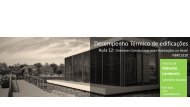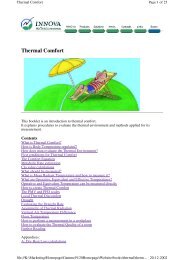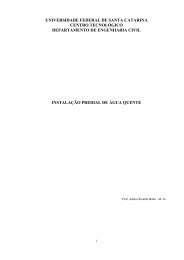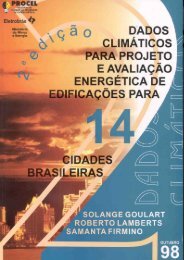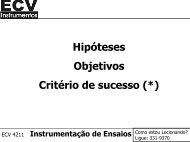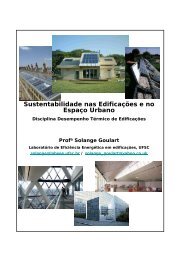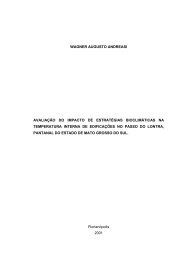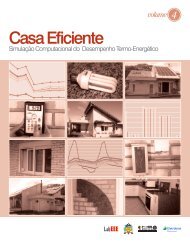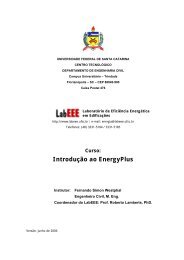ASHRAE STANDARD - 55R
ASHRAE STANDARD - 55R
ASHRAE STANDARD - 55R
Create successful ePaper yourself
Turn your PDF publications into a flip-book with our unique Google optimized e-Paper software.
BSR/<strong>ASHRAE</strong> Standard 55P, Thermal Environmental Conditions for Human Occupancy 2/24/03<br />
Third Public Review Draft (Independent Substantive Changes to the Second Public Review)<br />
7.4 Measuring Conditions.<br />
In order to determine the effectiveness of the building system at providing the environmental conditions<br />
specified in this Sstandard 55, measurements shall be made under the following conditions.<br />
To test during the heating period (winter conditions), the measurements required shall be made when the<br />
indoor-outdoor temperature difference is not less than 50% of the difference used for design and with<br />
cloudy to partly cloudy sky conditions. If these sky conditions are rare and not representative of the sky<br />
conditions used for design, then sky conditions representative of design conditions are acceptable.<br />
To test during the cooling period (summer conditions) the measurements required shall be made when the<br />
outdoor-indoor temperature difference and humidity difference are not less than 50% of the differences<br />
used for design and with clear to partly cloudy sky conditions. If these sky conditions are rare and not<br />
representative of the sky conditions used for design, then sky conditions representative of design<br />
conditions are acceptable.<br />
To test interior zones of large buildings, the measurements required shall be made with the zone loaded to<br />
at least 50% of the design load for at least one complete cycle of the HVAC system, if the system is not<br />
proportionally controlled. Simulation of heat generated by occupants is recommended.<br />
7.5 Mechanical Equipment Operating Conditions<br />
In order to determine appropriate corrective actions following the use of this Sstandard 55 to analyze the<br />
environment, the following operations of the mechanical system should be measured concurrently with the<br />
environmental data.<br />
• Air supply rate into the space being measured<br />
• Room/supply air temperature differential<br />
• Type and location of room diffuser or air outlet<br />
• Discharge air speed<br />
• Perimeter heat type, location and status<br />
• Return grille location and size<br />
• Type of air supply system if known<br />
• Surface temperatures of heated or cooled surfaces<br />
• Water supply and return temperatures of hydronic systems.<br />
7.6 Validating the Thermal Environment<br />
7.6.1 Define Criteria<br />
Before validating a thermal environment, the comfort criteria, specified by the design engineer and the<br />
owner, must be defined. From this definition, the validation or commissioning team will evaluate the<br />
system’s ability to meet and maintain the desired comfort level(s). The comfort criteria definition must<br />
outline, but not be limited to, the following:<br />
29


